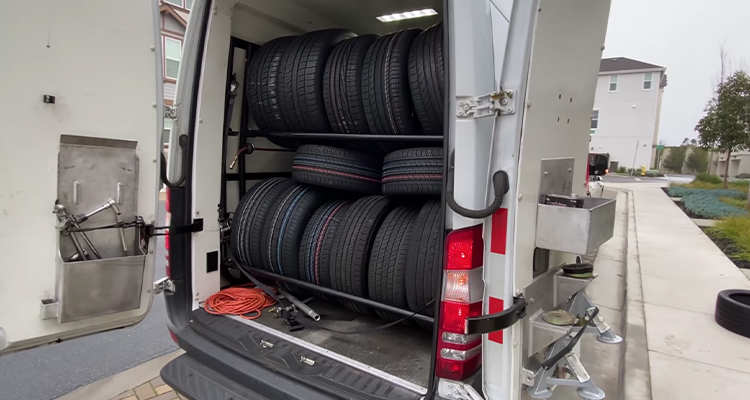Tire Service: Proven Techniques for Ideal Tire Maintenance and Care
Keeping optimum tire condition is vital for both security and efficiency of any car. From making certain proper tire pressure to regular rotation and placement, there are proven techniques that can considerably prolong the life-span of your tires and improve general driving experience. As we discover the complexities of tire care and maintenance, we will certainly discover necessary standards that every lorry owner need to follow for the finest possible results. Let's explore the world of tire solution and discover the tricks to keeping your tires in superior form for the long run.
Relevance of Tire Stress
Appropriate tire stress is a vital aspect in ensuring optimum car performance and safety on the roadway. Keeping the advised tire pressure levels supplied by the manufacturer supplies many advantages. Ample tire pressure promotes far better fuel efficiency, as under-inflated tires can lead to increased rolling resistance, triggering the engine to work more difficult and eat even more gas. Right tire stress guarantees even tread wear, boosting tire long life and conserving money in the lengthy run by delaying the need for early substitutes. Furthermore, appropriately pumped up tires add to boosted handling and braking capabilities, vital for risk-free driving in numerous roadway problems. Over-inflated tires, on the other hand, can cause reduced traction and a harsher ride. On the other hand, under-inflated tires are vulnerable to getting too hot, which can lead to blowouts and crashes. Consistently examining and readjusting tire stress, specifically eventually journeys, is a simple yet efficient means to boost car performance, expand tire life expectancy, and focus on safety on the road.
Tire Turning Guidelines
When taking into consideration tire turning guidelines, it is important to comprehend the importance of this maintenance job in making best use of tire life expectancy and preserving optimal vehicle efficiency. Tire turning includes transforming the setting of each tire on a lorry to make sure even tread wear. Front tires often tend to put on faster than back tires as a result of steering pressures, making normal turning critical for well balanced wear patterns. The recommended rotation pattern differs depending upon whether a vehicle is front-wheel, rear-wheel, all-wheel, or four-wheel drive. Usually, tires need to be revolved every 5,000 to 7,500 miles, or as recommended in the car manual. Neglecting tire turning can result in uneven wear, impacting handling, traction, and potentially compromising car safety and security. By sticking to appropriate rotation standards, drivers can prolong the life of their tires, improve fuel effectiveness, and boost overall driving experience. Routine turning is a simple yet efficient upkeep method that contributes dramatically to tire durability and car efficiency.

Benefits of Wheel Positioning
Making certain correct wheel positioning after tire rotation is critical for keeping balanced wear patterns and making the most of vehicle performance. Wheel positioning refers to the change of the angles of the wheels to the producer's requirements. Among the vital benefits of wheel alignment is boosted steering and taking care of response. When the wheels are appropriately straightened, it decreases steering initiative, guaranteeing a smoother and extra controlled driving experience. Furthermore, appropriate wheel alignment assists to extend the life-span of your tires. Misaligned wheels can trigger uneven tire wear, bring about premature tire substitute and boosted maintenance costs.

Tire Footstep Deepness Check
Carrying out a regular inspection of tire step depth is necessary for preserving secure driving conditions and prolonging the life expectancy of your tires. Unequal tread wear can show problems with tire suspension, pressure, or placement, highlighting the relevance of routine step deepness checks. By incorporating tire step depth checks right into your routine upkeep schedule, you can drive with self-confidence understanding that your tires are in leading condition.
Seasonal Tire Inspection
A thorough analysis of tire problem tailored to certain weather conditions is essential for maintaining optimal efficiency and security throughout the year. Seasonal tire assessment is a fundamental facet of tire maintenance that makes certain tires prepare to encounter the challenges presented by various climate condition. To prepare for winter, it is necessary to inspect the tire pressure routinely as cool temperature levels can cause tire stress to go down. Inspecting tire walk deepness is additionally important to make certain sufficient grip on snow and frozen roads. Furthermore, examining for indicators of wear and tear, such as lumps or splits, can aid prevent prospective tire failures. As the periods change, it is vital to evaluate tire condition and make any needed modifications to assure secure driving. By performing regular seasonal tire evaluations, chauffeurs can prolong tire life expectancy, enhance fuel effectiveness, and most notably, make certain a protected driving experience in differing climate condition - Flat Tire Repair Las Vegas.
Final Thought
To conclude, preserving proper tire pressure, revolving tires frequently, straightening wheels properly, checking tread depth, and performing seasonal evaluations are crucial practices for optimum tire treatment. By adhering to these confirmed techniques, chauffeurs can ensure their tires last longer, perform better, and add to overall vehicle security. home It is essential to prioritize tire upkeep to avoid accidents, boost gas effectiveness, and prolong the lifespan of tires.
Adequate tire stress advertises much better gas efficiency, as under-inflated tires can lead to increased rolling resistance, causing the engine to work more difficult and eat more gas.When thinking about tire turning standards, it is necessary to understand the importance of this maintenance job in making best use of tire life-span and moved here preserving optimum car performance. Seasonal tire evaluation is a basic element of tire maintenance that makes sure tires are prepared to face the difficulties positioned by various weather problems. By carrying out routine seasonal tire examinations, drivers can lengthen tire life expectancy, improve fuel performance, and most significantly, ensure a safe and secure driving experience in differing climate problems.
In final thought, maintaining proper tire stress, turning tires routinely, aligning wheels correctly, checking walk deepness, and conducting seasonal evaluations are crucial techniques for optimum tire treatment.